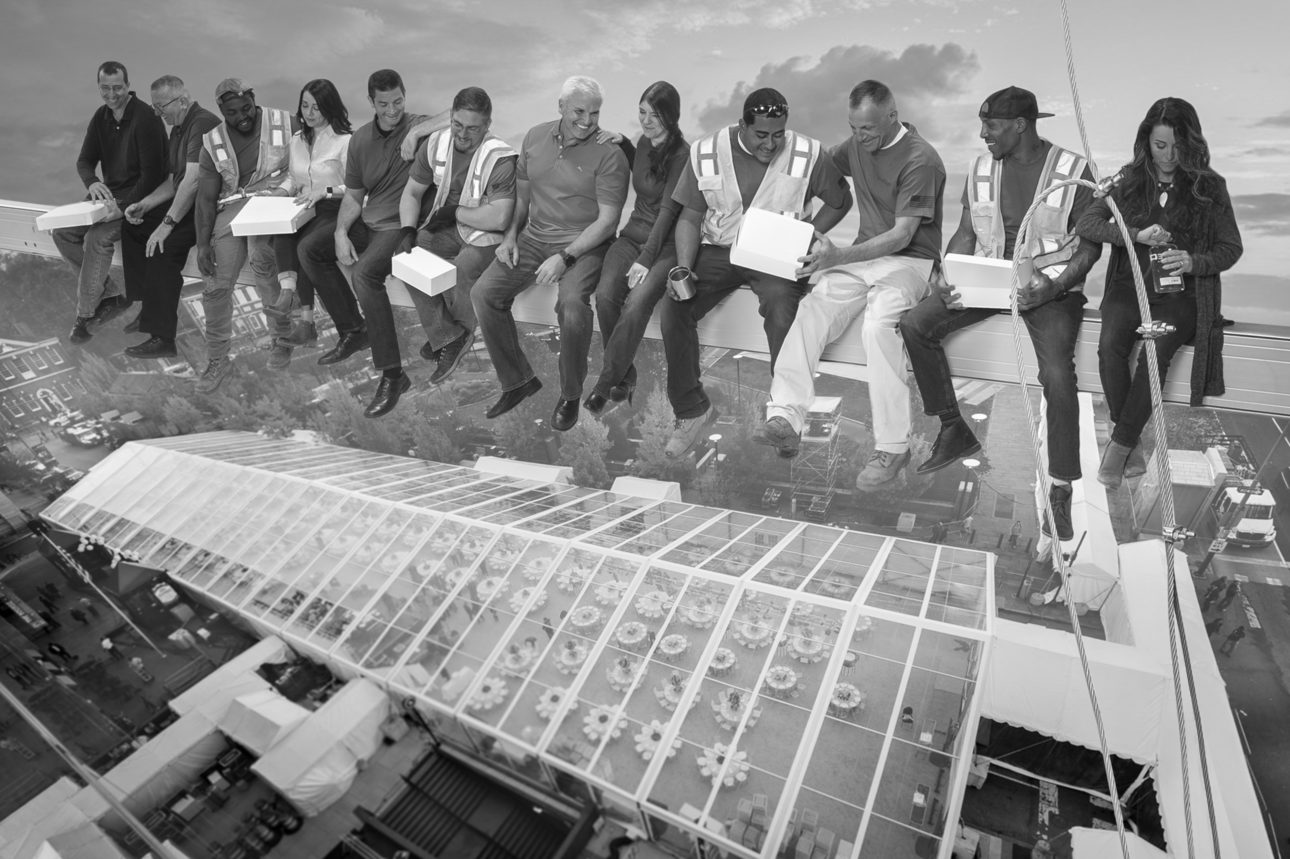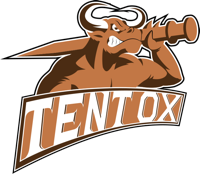From Zero to a Fleet of 4 Machines In One Year
HOW EVENTQUIP’S QUEST FOR PRODUCTIVITY LED IT TO TENT OX.

EventQuip of Montgomeryville, Pennsylvania https://www.eventquip.com/ is one of the biggest success stories in the tent rental sector. For 27 years it has concentrated on tent rentals, lighting, staging, power, floors, and climate control, working closely with other vendors who provide complementary services for event solutions ranging from sporting events in major cities to upscale weddings.
Founded by Ed Knight in 1994 with two tents, 20 tables, 200 chairs, a three-person staff and a few sledgehammers, EventQuip now stocks more than 1700 tents and structures and boasts a deep bench of dedicated, highly experienced professionals.

EventQuip’s marketing team recreated the famous “Lunch Atop a Skyscraper” photo that ran in a 1932 photo supplement
of the New York Herald Tribune. Here, company founder Ed Knight sits in the center with EventQuip staff members. Courtesy EventQuip – Tent Rental in Philadelphia, PA | Tents, Floors, Power and Climate Control Rentals
EventQuip’s on-the-job introduction to Tent OX started with a Tent OX machine rental in 2019 for three months. But in the midst of a busy season, crews were not trained on it, and so they were hesitant to take advantage of its several attachments, including a high-speed stake driver, stake puller and roof panel puller. “They used it as a forklift, primarily,” Ed explains.
Potential for Greater Productivity
Despite the false start with the 2019 rental, Ed and EventQuip’s senior team saw the productivity promise of Tent OX’s many labor-saving attachments. “We were interested in Tent OX because our overall goal here is to constantly increase quality and productivity. We cost out every job. We can determine the net gross that goes into the job, including removal. We also use a quick litmus test, with the net gross divided by variable hours, which yields a productivity number. We calculate that number for every job, and we can also review by job type.”
They decided in February of 2020 to buy one for the upcoming season. When they received it in April, training was the first priority. Crews were brought up to speed on how Tent OX would be taking over stake driving, stake pulling, and roof panel pulling tasks. As business began to pick up after the initial shutdown of business in March, EventQuip decided to go all in, adding more machines quickly to build a fleet of four Tent OX systems based on Avant 5, 7 and two 8 Series loaders.
“Now that we have adopted it, we know it would have made sense to buy Tent OX earlier,” Ed points out.
Riding the Wave of a Boom Year
This year, with business rebounding from the pandemic faster than anticipated, EventQuip depends on Tent OX to keep up with orders. “In August this year, we had double the activity we have traditionally seen,” Ed says. “After going through COVID-19 deprivation, customers are reacting by spending more heavily. We’re booking more events and customers are buying more upgrades like flooring and air conditioning.”
On top of all this new business, COVID-19 long-term rentals continue to deliver significant revenue. “We have more tents staying up for long periods and schools are still calling for outdoor space.”



Meeting the Demands of a Post-Pandemic World
With such a high number of jobs in play, maximizing productivity continues to be the key to keeping up. EventQuip’s truck fleet is dominated by extended cab 24-foot flatbeds, with four to five crew in the truck including a crew lead and a second. Jobs are organized around these crew sizes even when multiple crews are on the same job, allowing leads to adapt quickly to whatever they encounter.
For multi-day installs, a dedicated driver or drivers in CDL-class trucks distribute Tent OX systems to installation sites ahead of time, so the equipment is ready to go upon crew arrival.
“A Tent OX system does the work of two to four people,” Ed reports. “It used to take at least two people – and as many as eight people for 40- & 50-meter structures – to pull a roof panel. Or, we would use another machine to pull tops on our big structures, but the operator couldn’t really feel the tension when the top started to snag. As a result, we lost a couple of five to seven-thousand dollar tops each season.”
Using a Tent OX Roof Top Panel Puller, a single operator has his hands on the rope and can feel tension from a snag, and so, can stop pulling before the panel is damaged. “Let’s say that our Tent OX Systems cost an average of $85K each, which works out to about $14,000 a year over six years. That $14,000 is covered by what we save each year by not ruining roof panels,” Ed says. Additional savings and efficiencies beyond that amount to pure profit.
People Over Profit: How Tent OX Maximizes Both
Ed hastens to add that improved productivity isn’t the only benefit of owning the Tent OX. “There is the intrinsic value of not destroying your crew. Tent OX eliminates back-breaking labor, especially on pole tents. Crews are less fatigued, make fewer mistakes, have fewer injuries, and are able to deliver a better end result. If you talk to crew members who go between pole to structure installs, they would rather put up structure all day long; it’s more of an assembly process with lower risk of injury. Tent OX positively reduces injuries and strain on all jobs, but especially back strain on pole tents.“
What is there to learn from EventQuip’s journey to integrate an entire fleet of Tent OX tent installation systems into their business? There will always be a learning curve, and even some initial hesitation when it comes to change. Whether one buys one system or multiples, once Tent OX has been incorporated into the crew’s tasks, tent businesses tend to admit wishing they had pulled the trigger earlier.
If you desire similar results for your business, start a conversation with Tent OX. We’re happy to provide you with details and facts to help guide you toward the best decision for your situation. Contact us today!
